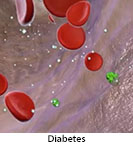
Diabetes: Glucagon Shot
________________________________________________________________________
KEY POINTS
- Glucagon shots may be given to treat a dangerously low blood glucose (sugar).
- Make sure you know how and when your child needs to take the medicine. Your child should not take more or less than he is supposed to take. Ask your provider if your child needs to eat a fast-acting source of sugar, such as a regular soft drink or fruit juice, and food with protein and fat, such as crackers and cheese after he has the shot.
- Ask your healthcare provider or pharmacist what side effects the medicine may cause, and what you should do if your child has side effects.
________________________________________________________________________
What is glucagon used for?
Glucagon shots may be given to treat a dangerously low blood glucose (sugar). Glucagon shots are used if the person is not able to eat or drink glucose. Taking glucose tablets or drinking a glucose drink raises blood glucose more quickly than shots. Give glucagon as soon as possible after seeing that the person with diabetes has low blood glucose. Call your healthcare provider or emergency services right away if you need to take or need to give glucagon. People with diabetes, and a family member if possible, should know the symptoms of low blood glucose and how to administer glucagon.
Symptoms of low blood sugar may include: shakiness, hunger, nervousness, or anxiety, grumpiness or irritability, sweating or chills, lightheadedness, nausea, headache, fast pulse, and confusion.
If your child has diabetes, talk to your provider about the need to keep glucagon on hand in case of an emergency.
How does it work?
Like insulin, glucagon is a hormone made in the pancreas. The 2 hormones have opposite effects.
- Insulin moves glucose out of the blood and into the cells. It keeps blood glucose from getting too high.
- Glucagon moves glucose stored in the liver into the blood. It keeps blood glucose from getting too low.
If your child has type 1 diabetes, the pancreas does not make enough glucagon. If your child cannot make enough glucagon, your child may not be able to raise his or her blood glucose when it gets too low. The glucagon shot does the work of the pancreas and raises the blood glucose.
What else do I need to know about this medicine?
- Glucagon comes in an emergency kit. The glucagon is a powder that must be mixed before use. Be sure you and a family member know how to mix the powder and liquid and how to give the shot.
- Follow the directions that come with the medicine, including information about food or alcohol. Make sure you know how and when your child needs to take the medicine. Your child should not take more or less than he or she is supposed to take.
- Right after your child has a shot of this medicine and starts to feel better, your child may need to eat a fast-acting source of sugar, such as a regular soft drink or fruit juice, and food with protein and fat, such as crackers and cheese, peanut butter, or a meat sandwich. Ask your child’s healthcare provider about this.
- Try to get all of your child’s prescriptions filled at the same place. Your pharmacist can help make sure that all of your child’s medicines are safe to take together.
- Keep a list of your child’s medicines with you. List all of the prescription medicines, nonprescription medicines, supplements, natural remedies, and vitamins that your child takes. Tell all healthcare providers who treat your child about all of the products your child takes.
- Many medicines have side effects. A side effect is a symptom or problem that is caused by the medicine. Ask your healthcare provider or pharmacist what side effects the medicine may cause, and what you should do if your child has side effects.
If you have any questions, ask your healthcare provider or pharmacist for more information. Be sure to keep all appointments for provider visits or tests.
Last modified: 2018-01-10
Last reviewed: 2018-01-10

